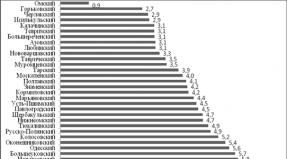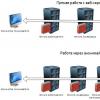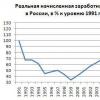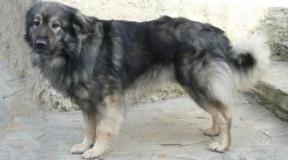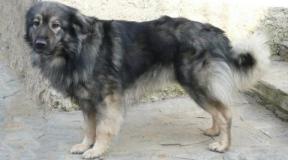Providing first aid for long-term compression syndrome. How to provide first assistance to victims of long-term squeezing the imposition of a harness during long-term compression syndrome
Crash syndrome, or prolonged squeezing syndrome, is traumatic toxicosis, which develops in the tissues of the limbs when they are released after long-term compression. The severity of such a state depends on how extensive damage in soft tissues, as well as from the time of being the victim under the rubble.
In medicine there are three types of this compression: compression, positional compression and crushing, but in most cases there is a combination of several varieties of injuries.
In the article, we will consider the main signs of this syndrome and ways to provide necessary assistance After extracting a person from under the severity that criticized him.
The main factors for the development of compression syndrome
The crash syndrome was described in time by researchers under different names: "liberation disease", traumatic toxicosis, as well as compression syndrome and a mining syndrome. Doctors emphasized that in the development of the named state, three circumstances are of the greatest importance:
- painful impact that causes a violation of equilibrium between the processes of excitation and braking in the CNS;
- traumatic toxmia formed due to the penetration of decomposition products from damaged muscles and tissues;
- plasmopoter, which is the result of extensive edema of injured limbs.
How the "liberation syndrome" develops
If we consider the pathogenesis of the crash syndrome, then the main reason for the occurrence of subsequent problems can be called ischemia (circulatory disorders) in some segment of the limb or in it as a whole, which is observed in combination with a stagnation of venous blood.
At the same time, nerve trunks are squeezed and traumatized, which leads to appropriate neuro-reflex reactions. In addition, crash syndrome is also mechanical damage to muscle tissue, which causes the release of a large amount of toxins (exchange products).

All described above leads to traumatic shock, receiving peculiar development due to the occurrence of intoxication and renal failure.
What has the biggest impact on the development of the pathological condition
The crash syndrome in all its manifestations is based more than the neuro-reflex component. Namely, on the long-term pain, which causes breathing spasms, disrupts blood circulation and entails, as a rule, thickening blood and the oppression of the process of urinary.
Immediately after the victim delivered the subject of the subject (by the way, the same happens after the removal of a long squeezing harness), Mioglobin and others begin to enter the blood toxic substances: Histamine, potassium, protein decay products, creatine, adenosine and phosphorus. Against this, the patient develops acute renal failure and symptoms that resemble the manifestations of traumatic shock.

The severity of the condition when crash syndrome
In medicine, 4 forms of clinical manifestations accompanying crash syndrome are distinguished:
- Easy. It occurs when the duration of the compression does not exceed four hours.
- Average form. Communication for 6 hours, usually the whole limb. In this case, the kidney function is disturbed by little and there are no obvious hemodynamic disorders.
- Heavy. After compressing the whole limb for 7-8 hours (by the way, it is most often about foot). At the same time, signs of renal failure are clearly manifested.
- Extremely severe form. It is observed in the case of squeezing both limbs for more than 6 hours. As a rule, victims die from manifestations of renal failure already in the first three days after injury.

What do the manifestations of crash syndrome look
The symptoms accompanying syndrome are directly dependent on how long the squeezing continued to which area it was distributed, and whether the accompanying damage to the internal organs, bones, vessels and nerves was.
After the release of the majority of injured, as a rule, a satisfactory state is observed from the majority of victims. Patients complain mainly on nausea, weakness and pain in damaged limbs. The last pale painted and have traces of compression (dents). On the peripheral arteries in them, the pulsation is weakened.

The edema of the limbs is developing quickly - they strongly increase the volume and become rustic to the touch, and the pulsation due to the spasm of the vessels disappears at all, from which the limbs are cold. The growth of edema accompanying the crash syndrome (you can see it here), provokes the deterioration of the victim's condition, which becomes weak, sluggish, drowy. He has a heart matter, the pressure drops to critical marks, and the pain in the limbs increases.
How the signs of crash syndrome develop
The sign of the early period of the crash syndrome is oligurauria (this is a process in which the patient is strongly reduced by the amount of urine allocated). Watering has a reddish color due to the presence of hemoglobin and myoglobin in it, a sour reaction and high density.
If the recovery accompanying treatment is timely, on the 3rd day in patients improved well-being, and the edema decreases. But, unfortunately, nausea, vomiting, weakness and signs of Uremia appear on the 4th day. The patient is tormented by pain in the lower back and symptoms of renal failure. The condition is still worsening, and death may occur for 8-12 days against Uremia.

But with proper treatment to the 12th day, the described signs subscribe and the period of gradual recovery occurs. True, the complete restoration of the limb, as a rule, does not happen - there is muscle atrophy, contracture.
Crash syndrome: emergency care and treatment
In the treatment of crash syndrome, it is very important whether the necessary first assistance has been rendered correctly under the dawns. Immediately after it is extracted, the limb is necessary to pull the harness above the injury (i.e. closer to the body) and tight stabbing to prevent the appearance of edema. It is also desirable to impose ice on it, which will help reduce the development of hypercalemia and reduce tissue sensitivity to oxygen starvation.
Mandatory accompanying Crash Syndrome is the introduction of painkillers and sedatives.
It should be remembered that in the case of the slightest doubt in the speed of delivery of a patient in the medical institution, you need to remove the harness immediately after tight binting and the cold compress - otherwise the process of tissue s correspondence can begin.
Treatment is carried out in the intensive care unit, from the first hours of the patient overflows large volumes of freshly frozen plasma, hemodes and salt mortar. Heparin is introduced under the skin of the belly, antibiotics, disagrements, Laziks and Trasilol are prescribed. If necessary, hemodialysis is carried out. In the presence of complicated edema, the patient shows the Faziotomy, and with the development of gangrenes - the amputation of the limb.
Modern look at the pathogenesis, diagnosis and sterling treatment of long-term compression syndrome.
Pathogenesis of long-term syndrome
Pathological changes at SDS.
Clinical SDS Picture.
Treatment at the stages of medical evacuation
Among all the closed damages, a long-term compression syndrome occupies a special place, which arises as a result of a long grave of limbs during collaps, earthquakes, structures of buildings, etc. It is known that after an atomic explosion over Nagasaki, about 20% of victims had more or less pronounced clinical signs of long-term compression or crushing syndrome.
The development of syndrome similar to the syndrome, compression is observed after the removal of the harness imposed for a long time.
IN pathogenesis Three factors have the highest value of the compression syndrome:
pain irritation, causing a violation of coordination of excitatory and braking processes in the central nervous system;
traumatic toxemia due to the suction of the decay products from damaged tissues (muscles);
plasmotherly arising secondly as a result of massive edema of damaged limbs.
The pathological process is developing as follows:
As a result of the compression, it arises ischemia of the limb segment or limb entirely in combination with venous stagnation.
At the same time, traumatization and squeezing are large nervous trunks, which causes the corresponding neuro-reflex reactions.
Mechanical destruction is mainly muscle tissue with the release of a large number of toxic products of metabolism. Heavy ischemia causes both arterial failure and venous stagnation.
In lengthy syndrome, a traumatic shock occurs, which acquires a peculiar course due to the development of severe intoxication with renal failure.
The nervous reflex component, in particular, long-term pain irritation, has a leading value in the pathogenesis of the compression syndrome. Pain irritations violate the activities of respiratory organs, blood circulation; The reflex spasm of the vessels occur, the oppression of the urination, blood is thicken, the resistance of the body is reduced to blood loss.
After the liberation of the injured from the compression or removal of the harness in the blood, toxic products are beginning to flow and above all Mioglobin. Since myoglobin enters the bloodstream on the background of a pronounced acidosis, falling into a precipitated acid hematin blocks the rising kennel of the loops of Genla, which ultimately disrupts the filtration capacity of the kidney channel apparatus. It has been established that Mioglobin has a certain toxic action that causes necrosis of the tubular epithelium. Thus, myoglobinemia and myoglobinuria are essential, but not the only factors that determine the severity of intoxication from the victim.
Admission to the blood of other toxic substances: potassium, histamine, derivatives of adenositriphosphate, products of the autolytic decay of proteins, adenilic acid and adenosine, creatine, phosphorus. In the destruction of the sinks into the blood, a significant amount of aldolase comes (20-30 times higher than the norm). In terms of aldolase, you can judge the severity and scales of muscle damage.
Significant plasmotherly leads to a violation of the rheological properties of blood.
The development of acute renal failure, which is manifested in different ways at various stages of syndrome. After elimination of compression, symptoms develop, resembling traumatic shock.
Pathological anatomy.
The graduated limb sharply edema. Skin covers pale, with a large amount of abrasion and bruises. The subcutaneous fatty tissue and muscles are tested with eating fluid, yellowish color. The muscles are embesed by blood, have a dim, the intake of vessels is not broken. With a microscopic examination of the muscle, a characteristic picture of wax degeneration is detected.
There is a brain swelling and full-row. Light stagnant-full, sometimes there are edema phenomena and pneumonia. In myocardium - dystrophic changes. In the liver and the organs of the gastrointestinal tract, a full-drift with multiple hemorrhages in the mucous membrane of the stomach and the small intestine are noted. The most pronounced changes in the kidneys: the kidneys are increased, a sharp pallor of the cortical layer is expressed on the section. In the epithelium of convinced tubules, dystrophic changes. In the lumen of the tubules contain grainy and fine-closed protein masses. Part of the tubules are completely clogged with Mioglobin cylinders.
Clinical picture.
Mix 3 periods in the clinical course of compression syndrome (according to M.I. Kuzin).
I period: from 24 to 48 hours after liberation from compression. In this period, the manifestations that can be considered as traumatic shock are quite characteristic: pain reactions, emotional stress, direct consequences of plasma and blood loss. It is possible to develop hemoconcentration, pathological changes in the urine, an increase in the residual blood nitrogen. The compression syndrome is characterized by a light gap, which is observed after the provision of medical care, both at the scene and in a medical institution. However, the condition of the victim soon begins to deteriorate again and develops II period, or intermediate.
II period - intermediate, - from 3-4th to 8-12th day, - development primarily renal failure. The edema of the liberated limb continues to increase, bubbles, hemorrhage formed. The limbs acquire the same appearance as for anaerobic infection. In the study of the blood, progressive anemia is detected, the hemokoncentration is replaced by hemodilution, diuresis decreases, the level of residual nitrogen is growing. If the treatment is ineffective, Anuria and Uremic Coma are developing. Mortality reaches 35%.
III Period - Recovery - It usually begins with 3-4 weeks of the disease. Against the background of normalization of kidney function, positive shifts in protein and electrolyte balance There are severe changes from the affected tissues. These are extensive ulcers, necrosis, osteomyelitis, purulent complications from the sister, phlebitis, thrombosis, etc. Often these heavy complications that sometimes end in the generation of purulent infection, lead to a fatal outcome.
A special case of a long-term compression syndrome is a positional syndrome - long-term detection in the unconscious state in one position. With this syndrome, the compression occurs as a result of the tissue of tissues under its own weight.
There are 4 clinical forms of long-term syndrome:
Easy - arises in cases where the duration of the grave of the limb segments does not exceed 4 hours.
The average - compression, as a rule, of the entire limb for 6 hours. In most cases, there are no severe hemodynamic disorders, and the kidney function suffers relatively little.
A severe form arises due to the compression of the entire limb, more often hip and lower legs, for 7-8 hours. Symptoms of renal failure and hemodynamic disorders are clearly manifested.
Extremely severe form develops if both limbs are subjected for 6 hours or more. The victims die from acute renal failure during the first 2-3 days.
Severity clinical picture Surveillance syndrome is closely related to the strength and duration of the compression, the area of \u200b\u200blesion, as well as the presence of accommodate damage to the internal organs, blood vesselsbones; nerves and complications developing in crushed tissues. After liberation from the compression, the general condition of the majority of victims is usually satisfactory. Hemodynamic indicators are stable. The victims are bothering pain in damaged limbs, weakness, nausea. The limbs have a pale color, with the traces of compression (dents). There is a weakened ripple on the peripheral arteries of the damaged limbs. The edema of the extremities is developing rapidly, they increase significantly in volume, acquire a rustic density, vascular pulsation disappears as a result of compression and spasm. The limb becomes cold to the touch. As the edema increases, the state of the victim deteriorates. Appear total weakness, lethargy, drowsiness, pallor of skin, tachycardia, blood pressure drops to low numbers. The victims feel significant pain in the joints when trying to produce movements.
One of the early symptoms of the early period of the syndrome is oliguraury: the amount of urine for the first 2 days is reduced to 50-200 ml. With severe forms, Anuria occurs sometimes. Restoration arterial pressure It does not always lead to an increase in diuresis. Urine has a high density (1025 and higher), an acidic reaction and red color, due to the release of hemoglobin and myoglobin.
By the 3rd day, by the end of the early period, as a result of treatment, the well-being of patients is significantly improved (light gap), hemodynamic indicators stabilizes; Edema extremities decreases. Unfortunately, this improvement is subjective. Diuresis remains low (50-100 ml). On the 4th day, the clinical picture of the second period of the disease begins to form.
Nausea, vomiting, general weakness, lethargy, stiffness, apathy, signs of Uremia appear again to the 4th day. There are pains in the lower back, due to stretching of the fibrous kidney capsule. In this regard, sometimes a picture of a sharp abdomen is developing. The symptoms of pronounced renal failure are increasing. Continuous vomiting appears. The level of urea in the blood of age is up to 300-540 mg%, it drops alkaline blood reserve. Due to the increase in Uremia, the patient's condition is gradually deteriorating, high hypercalemia is observed. Death occurs on 8-12 days after injury against Uremia.
With the right timely treatment By 10-12 days, all the renal failure are gradually subsided and the late period occurs. In the late period, the local manifestations of compression syndrome, swelling and pain in the damaged limb are gradually reduced and completely disappear by the end of the month. The complete restoration of the limb function usually does not happen, due to damage to large nerve trunks and muscle tissue. Over time, most of the muscle fibers die, replacing the connective tissue, which leads to the development of atrophy, contractures. In this period, severe purulent complications of general and local character are observed.
Treatment at the stages of medical evacuation.
First Aid: After the release of the graduated limb, it is necessary to impose harness to the proximum compression and tight to bandage the limb to prevent edema. It is advisable to carry out hypothermia limbs using ice, snow, cold water. This measure is very important, since the development of massive hypercalemia is preventing a certain extent, reduces the sensitivity of tissues to hypoxia. Immobilization, introduction of painkillers and sedatives. With the slightest doubt about the possibility of rapid delivery of the victim in medical institutions, it is necessary after the binting of the limb and its cooling, to remove the harness, transport the victim without a harness, otherwise the finiteness is realistic.
First medical care.
They produce a novocaine blockade - 200-400 ml of a warm 0.25% solution proximal than imposed harness, after which the harness is slowly removed. If the harness was not superimposed, the blockade is performed proximal to the level of compression. It is more useful to introduce antibiotics in the novocain solution wide spectrum actions. Also perform two-sided panefral blockade by A.V. Vishnevsky, inject tetanus anatoksin. Cooling limb with tight bandaging should be continued. Instead of tight binting, the use of a pneumatic tire for immobilization of fractures is shown. In this case, the uniform compression of the limb and immobilization will be simultaneously carried out. Drugs and antihistamine are introduced (2% Pantrophone solution 1 ml, 2% solution of diphrol 2 ml), cardiovascular means (2 ml of 10% caffeine solution). Immobilization of standard transport tires is performed. Give alkaline drink (drinking soda), hot tea.
Qualified surgical care.
Primary surgical processing of the wound. The combating of acidosis is the introduction of a 3-5% solution of sodium bicarbonate in an amount of 300-500 ml. A large doses are prescribed (15-25 g per day) sodium citrate, which has the ability to squeeze urine, which prevents the formation of myoglobin precipitation. It is also shown to drink the worst quantity of alkaline solutions, the use of high sodium bicarbonate. To reduce the spasm of the vessels of the cortex layer of kidneys, intravenous drip infusion 0.1% of the novel solution (300 ml) are appropriate. During the day is introduced into a vein to 4 liters of liquid.
Specialized surgical assistance.
Further receipt of infusion therapy, Novocaine blockades, correction of exchange disorders. Also produced a full surgical processing of wounds, amputation of limbs according to indications. Extracorporal detoxification is performed - hemodialysis, plasmifferez, peritoneal dialysis. After the elimination of acute renal failure, therapeutic measures should be directed to the restoration of the function of the damaged limbs, the fight against infectious complications, the prevention of contractures. Operational interventions are produced: opening phlegmon, clogging, removal of necrotic sites of muscles. In the future, physiotherapy procedures and physiotherapy are applied.
Long-term compression syndrome (Synonym:, crushing syndrome, compression, crash syndrome)
pathological condition, developing after a long grave for a large mass of soft tissues. It is found among victims during earthquakes, ripples in mines, collaps and others. As a rule, S. d. With. comes with compression, the duration of which is over 4 c. (sometimes less), and the mass of injured tissues exceeding the mass of the upper limb. There is also a positional compression, or a positional compression that occurs as a result of a long fixed position of the body of the victim, located in an unconscious state (, poisoning, etc.) or in a state of deep pathological sleep. At the same time, the compression of relaxed tissue mass of its own body is developing. Of great importance in the development of S. d. It has . Inxication in the initial stages of S. d. Conducted toxic substances formed in tissues when damaged. As a result of a long grave of the limb, the ischemia of the entire limb or its segment is developing in combination with venous stagnation. Squeezed, nerves and. The amount of oxygen in the blood is reduced, carbon dioxide and other molecular decay products are removed, which accumulate in the composed part of the body. As soon as the compression of the tissues ceases, toxic products are entered into the bloodstream and cause severe intoxication. The leading factors of toxmia are:, achieving often 7-12 mmol / L.; leading to the blockade of kidney channels; An increase in the formation of biogenic amines and vasoactive polypeptides (spree products of proteins, histamine, adenyl acid, creatinine, etc.), as well as proteolytic lysosomal enzymes, exemed during the destruction of cells: the development of autoimmune state. IN early stages S. d. With. First of all, they are affected, which is manifested by the destruction of the epithelium of the tubules, stas and thrombosis both in cortical and a cerebral substance. Significant dystrophic changes are developing in renal tubules, the lumens of which are filled with the products of the decay of cells. And the erythrocyte-produced hemolysis is free reinforce the achemia of the kidney cortical substance, which contributes to the progression of the process and the development of acute renal failure (renal failure). Long-term compression of the limb segment, the development of oxygen starvation and hypothermia in its tissues leads to pronounced tissue acidosis. Negatively affects the function of the kidneys, liver, intestines. The oxygen deficiency leads to an increase in the permeability of the intestinal wall and the violation of its barrier function. Therefore, the toxic substances of the bacterial nature are freely penetrated into the portal system and block elements of the system of mononuclear phagocytes of the liver. Violation of the antitoxic function of the liver and contribute to the liberation of the vasopressor factor - ferritin. Disturbances of hemodynamics at this state are associated not only to form vasopressors, but also with massive destruction of red blood cells, which leads to hypercoagulation and intravascular thrombosis. Clinical picture. The severity of clinical manifestations of S. d. S. It depends on the degree and duration of the grave of the limb, the volume and depth of the lesion, as well as from the combined other organs and structures (crank-brain, injuries of internal organs, bones, joints, vessels, nerves, etc. Distinguish 3 periods S. d. I period (initial) is characterized by local changes and endogenous intoxication. It lasts 2-3 days. After release from compression. It is typical of the relatively prosperous state of victims immediately after extracting from the rippled. Only in a few hours there are local changes in the segment that has been squeezed. It becomes pale, fingers appear, quickly increases swelling, acquires a rigid density. Peripheral vessels is not determined. With the deepening of local changes, the overall state of the victim deteriorates. The manifestations of traumatic shock prevail: pain syndrome, psycho-emotional, instability of hemodynamics, creatininemia. The condition of the victim can rapidly deteriorate with the development of acute cardiovascular insufficiency. Increases fibrinogen, plasma increases for heparin, the fibrinolytic system is reduced, i.e. Increases blood coagulation system, which leads to thrombosis (see Thrombohemorrhagic syndrome). It has a high relative density, protein, cylinders appear in it. In peripheral blood, concentration, shift, are noted. Plasmotherly leads to a significant reduction in the volume of circulating blood and plasma. II period (intermediate) - a period of acute renal failure - lasts from 3-4 to 8-12 days. Empinted edema of the limb subjected to comprehension, which is accompanied by the formation of bubbles with transparent or hemorrhagic content, dense infiltrates, local, and sometimes total necrosis of the entire limb. Hemodilia is replaced, increases, decreases sharply, up to Anuria. In the blood, the content of residual nitrogen, urea, creatinine, potassium increases, the classical picture of Uremia is developing. Increases, the condition of the victim sharply deteriorates, the lethargy and inhibition, and the thirst, and the skin and skin appear. Mortality in this period can reach 35% despite the intensive therapy. III Period (Recovery) begins with the 3-4th week. During this period, local changes are dominated by common. The kidney function is restored. Infectious complications of open damage are infectious complications, as well as wounds after lamps, and fascidomy. Possible infection with the development of sepsis. In uncomplicated cases, the edema of limb and pain in it by the end of the month pass. In victims, pronounced anemia, disproteinemia (, hypergobulinemia), hypercoagulation of blood; Changes in the urine (protein, cylinders). These changes are persistent and, despite the intensive infusion therapy, tend to normalize on average by the end of the month of intensive treatment. A sharp decrease in factors of natural resistance and immunological reactivity is revealed. The bactericidal blood activity is reduced, serum lysozyme activity. For a long time, the indicators of the leukocyte intoxication index indicate the presence of an autoimmune state and pronounced intoxication remain elevated. Most victims have a long deflection in emotional and mental status in the form of depressive or jet psychosis and hysteries. In a bacteriological study, the overwhelming majority of injured from earthquakes is detected high degree The seeding of the Russian Academy of Sciences by Klostridy in Association with Enterobacteria, Pseudomonads and Anaerobic Cockkops. This causes a high risk of developing in these patients with clostridial meecroxes. As a result of therapeutic measures, they are usually cleaned from clostrid after 7-10 days. At a later dates from the Russian Academy of Sciences, it is highlighted in association with enterobacteria, staphylococci and some other bacteria. Treatment The victims should be comprehensive, in compliance with the straticness and continuity of the provision of therapeutic benefits. On the chipboard After the liberation of the victim at the scene should include the introduction of painkillers (Promedol, Obanopon, Morphine, Analgin), sedative and antihistamine funds, with the possibility of 0.25% mortar in the proximal department of the graduated limb, tight binting of the limb to an elastic or gauze bandage , Transport immobilization, local hypothermia in the form of a lap by the damaged limb with ice bubbles. If there are wounds, they carry out their mechanical cleaning, apply with antiseptic and dehydrating properties. During evacuation, immobilization is performed, the introduction of painkillers and sedatives continues to introduce infusion therapy (polyglyukin, refooliglukin, 5% glucose solution, 4% sodium hydrocarbonate solution, etc.). For the prevention of the wound infection, combinations of a wide range of action antibiotics are used with the mandatory inclusion of the antibiotic antibiotic group of the penicillin group (given the frequent from the RAS clostridial flora). At the hospital stage there are intensive anti-deposit and resuscitation activities. The number and composition of intravenously administered transfusion media in the amount of 2,000-4,000 ml And more per day is adjustable according to the daily diurea and homeostasis. The composition of the fluids of liquids includes freshly frozen plasma, glucosonic mixture, 5% solution of glucose with vitamins, 5% or 10% albuin solution, 4% sodium hydrocarbonate solution, mannitol solution at the rate of 1 g. per 1 kg of body weight, disinfectants (hemodez, neogenesis). For stimulation, diuresis is prescribed furosemide to 80 mg.and more than a day, Papaverin, Eufillin, with the aim of preventing thrombosis, introduced 2,500 users 4 times a day, disagrements (dipyridamol, pentoxifillin), and phenobolin, cardiovascular, immunocormers are used according to indications. In the prevention of acute renal failure, the use of Prostaglandin E 2 (simple-pin), which is administered intravenously for 3-5 days. Intensive conservative should provide in an amount of at least 30 mlat one o'clock. With the ineffectiveness of the treatment carried out within 8-12 c., namely, when dropping diuresch to 600 ml/ day. and below, increase the level of hypercalemia more than 6 mmol / L., creatininemia above 0.1 mmol / L., the appearance of signs of brain edema and lungs, shows the conduct of hemodialysis A in ultrafiltration mode. Infusion therapy in the interdia-phase period is carried out in the amount of 1500-2000 ml. The injured with pronounced intoxication shows the holding of plasmapheresis (see plasmapheresis, cytapopheresis), which ensures the most complete removal from the organism of the toxic products of metabolism. Hyperbaric oxygenation sessions (hyperbaric oxygenation) reduce the degree of hypoxia tissues. For the purpose of disintellation daily make cleaning, enter the enterodez of 1 teaspoon in 1/2 cup of water 3 times a day or. When bleeding due to uremia and disseminated intravascular coagulation, the emergency carrying out of plasmapheresis followed by a transfusion of fresh frozen plasma to 1000 ml, the purpose of the protease inhibitor (Gondoksa, Pontical) against the background of the ongoing introduction of heparin 2,500 users 4 times a day. Surgical tactics should be active and depends on the state of the victim, the degree of ischemia of the damaged limb, the presence or absence of bones and bone fractures. Pronounced swelling and voltage of soft tissues of the graduated segment of the limb, the appearance of bubbles with hemorrhagic content, the rapid increase in cyanosis indicate coarse disorders of microcirculation and the risk of the development of an extensive necrotic process. Conducting wide fireciotomy with dissemination of fascial cases can restore and eliminate tissue compression. After the fisiotomy, the skin impose rare seams with leaving drainage tubes. The unvisability of the subjugation of the limb is an indication of its amputation. In the presence of the mischief wounds, a thorough primary surgical treatment with a wide disclosure of wounds, excision of obviously non-visual tissues, removal of foreign and freely lying bone fragments, abundant washing with antiseptics. The imposition of deaf seams and performing the operation of the skin plastic is unacceptable, as the tissues can continue in the following days. The fixation of bone fractures should be carried out with the help of compression and distraction devices at first, even without final and complete adaptation of fragments. In the absence of capabilities or conditions for these devices, the fixation is performed by plaster flashes (the circular gypsum bandage cannot be applied!) Or skeletal extract (if it is not planned to be affected by other specialized institutions). Submersible revolutionary or intraosseous fractures of bones of limbs, subjugated, contraindicated. In the following days, depending on the state of the victim, the position correction is carried out correction of fragments, etching necrectomy, intense local treatment with the use of funds with antiseptic, enzyme and dehydrating properties. After cleaning the wound surface from necrotic tissues and the appearance of fresh granulation, free and non-free skin elastics are carried out (see plastic surgery). In the late recovery period, the victims need rehabilitation-reducing treatment with the use of LFC, physiotherapeutic methods and sanatorium-resort treatment. According to the testimony, reconstructive restoration interventions are performed. Bibliography: Komarov B.D. And Shimanko I.I. Positional tissue compression, M., 1984; Kochnev O.S.
Under the syndrome of a long compression is understood as a number of symptoms after a long tissue hypoxia caused by mechanical compression of vessels. In severe cases, SDS leads to necrosis of muscle and nerve tissues. Prefigure help The wounded with the SDS allows preventing complications of tissue hypoxia, including toxycia, hepatic and renal failure, which is accompanied by traumatic toxicosis.
Classification
Several classifications of long-term compression syndrome. If we talk about the types of compression, then exists:
- position syndrome - local damage of predominantly limbs under the weight of its own weight in the case of long immobility;
- crushing - Open variation of injury;
- direct compression - It occurs in the case of pressed the subject of a large mass for a long period.
Traumatic toxicosis has a different clinical course, due to the scale of damage and the degree of gravity of injury. Compression injury of light shape does not cause significant disorders, and blood circulation over time is completely restored. A other business is compression injuries internal organs and spine. Together with a long-term compression syndrome can lead to a fatal outcome. And they are considered the most dangerous. Pain syndrome often causes shock, and hypoxia of fabrics - necrosis and comatose state.
The concept of traumatic toxicosis includes disorders of the following intensity:
- syndrome - implies squeezing predominantly limbs for a period of up to 4 hours. Forecast SDS easy degree favorable;
- syndrome of moderate severity - symptom complex with developing hypoxia, occurs with compression for a period of 4 - 6 hours;
- heavy Crash Syndrome - arises after 6 hours of squeezing, accompanied by renal failure, the appearance of areas of necrosis. By definition has heavy flow, but successfully treated with early detection;
- extremely heavy crash syndrome - This state occurs after 8 hours of compression. The term "extremely severe traumatic toxicosis" implies states life-threatening.
During the traumatic toxicosis, doctors distinguish three periods:
- period of increasing swelling and vascular disorders;
- involvement in the pathological process of kidneys, liver, lungs;
- stage of recovery.
ICB 10 injury code
Since the SDS has many diagnoses of synonyms, difficulties arise with the identity of the disease. In the case of identifying such violations, the code on the ICD - T79.5 is assigned. Under this encoding is hidden by traumatic Anuria, it is the same Bayuoteurs or Discharge syndrome, SDS, ATP, Mioen syndrome, traumatic toxicosis.
The reasons
The syndrome of a long compression of soft, mostly muscle tissues is developing as a result of a combination of three mandatory elements:
- loss of liquid blood due to trauma of vessels and other fabrics;
- the development of pain syndrome, possibly shock states;
- the body poisoning with necrotic tissues and other toxic products formed during fabric breakdown.
 The pathogenesis of prolonged squeezing syndrome is due to a long stay under fabric hypoxia. The causes of such states are earthquakes, collaps and dawns due to natural disasters. In children, signs of compression arise faster than adults. While the victim is removed from under heavy dawns, he can lose a lot of blood and earn renal failure.
The pathogenesis of prolonged squeezing syndrome is due to a long stay under fabric hypoxia. The causes of such states are earthquakes, collaps and dawns due to natural disasters. In children, signs of compression arise faster than adults. While the victim is removed from under heavy dawns, he can lose a lot of blood and earn renal failure.
Promotional causes of Light Form CDS are proliferated by their own bodies of limbs when falling in a state of alcoholic or drug intoxication. By the time a person comes to himself, his soft fabrics Have time to survive hypoxia.
Symptoms
 Call an accurate clinic of long-term syndrome, based on the process stage. The expressed pain syndrome is observed immediately after injury. Then, when transmitting sensitivity decreases, the limb is cold, the vessels do not cope with the transport function. The patient's condition is worsening every hour. The swelling of the damaged limbs increases, the place of damage is shine. When traumatizing vertebrals or skulls rapidly grow symptoms of functional failure.
Call an accurate clinic of long-term syndrome, based on the process stage. The expressed pain syndrome is observed immediately after injury. Then, when transmitting sensitivity decreases, the limb is cold, the vessels do not cope with the transport function. The patient's condition is worsening every hour. The swelling of the damaged limbs increases, the place of damage is shine. When traumatizing vertebrals or skulls rapidly grow symptoms of functional failure.
If the victim does not receive help for a long time, death comes. If one limb was submitted, necrosis develops. Signs of death limb are:
- enthancing, erosion;
- exposure of muscles;
- damaged tissues acquire the color of boiled meat.
At the same time, acute renal failure increases, signs of cardiac arrhythmia, bradycardia appear.
Clinical manifestations of Middle and Heavy SDUS are associated with the functions of the internal organs. The general state is sharply deteriorated, toxic hepatitis is not excluded with the possible development of polyorgan deficiency.
In the intermediate period of the long-term compression syndrome, the main pathological manifestations are distinguished: a decrease in acute symptoms for 2 weeks from the date of injury, the growing of remote complications - atrophy, contractures, local inflammatory reactions. The clinic of long-term syndrome is reduced in case of timely medical care.
First aid
Immediately after exemption from under the debris or other adverse conditions, first medical assistance is provided with long-term compression syndrome. The algorithm of action includes:
- above part of the compression is tightened by harness on the injured limb;
- impose a gulling bandage;
- wounds sanitate;
- give painkillers, narcotic analgesics are not excluded.
 The imposition of a harness at the prehospital stage at the SDS is necessary to stop the spread of toxins. With the same purpose shows tight binting. Methods and means of anesthesia at different stages of medical care varies. Urgent Care At the scene in the syndrome of a long compression does not exclude resuscitation Actions. From the timing and quality of the first medical care, it depends on how successful will the recovery of the victim in the syndrome of a long crushing.
The imposition of a harness at the prehospital stage at the SDS is necessary to stop the spread of toxins. With the same purpose shows tight binting. Methods and means of anesthesia at different stages of medical care varies. Urgent Care At the scene in the syndrome of a long compression does not exclude resuscitation Actions. From the timing and quality of the first medical care, it depends on how successful will the recovery of the victim in the syndrome of a long crushing.
If less than 2 hours passed since the accident, the sequence of actions during the provision of medical care will be different. The patient with long-term squeezing syndrome in the absence of signs of necrotization - sinushesity, swelling, loss of sensitivity, allowed to warm.
Long-term compression syndrome in the first stage does not have a destructive effect on the body, which means that the first assistance in the syndrome of a long-term compression allows the use of methods and means stimulating blood flow. If the time of the tragedy is unknown, provide standard first assistance, the feature of which is the refusal of rapid liberation from the gulling cargo.
Diagnostics
 To identify traumatic toxicosis is possible during the inspection of the victim. In the case of long-term blood microcirculation disorders, stagnant phenomena occurs, possibly with necrosis. Evaluate the danger of compression allow laboratory methods diagnostics that determine blood viscosity and inflammatory process. Electrolytic disorders are observed, the concentration of glucose and bilirubin increases.
To identify traumatic toxicosis is possible during the inspection of the victim. In the case of long-term blood microcirculation disorders, stagnant phenomena occurs, possibly with necrosis. Evaluate the danger of compression allow laboratory methods diagnostics that determine blood viscosity and inflammatory process. Electrolytic disorders are observed, the concentration of glucose and bilirubin increases.
In traumatology and orthopedics used radio diagnostics: radiography, CT, MRI. In case of kidney and liver damage, urine tests are of great importance. High level Mioglobin testifies to renal failure. In the development of acidosis increases acidity.
Metabolic acidosis is developing at the initial stage of the SDS. In the toxic period, blood coagulation is disturbed, the creatine content in the urine increases, serum albumin is detected.
Treatment
 Intoxication develops rapidly, so it is important to reduce toxic action Disintegration products inside the body. For this purpose, a solution of glucose and salt solutions prescribe. By decision of the doctor, albumin preparations are used. In the early period 1, only detoxification of the body is enough to eliminate the basic symptoms of a long-term crushing syndrome, but specific treatment is required to restore the limb functions.
Intoxication develops rapidly, so it is important to reduce toxic action Disintegration products inside the body. For this purpose, a solution of glucose and salt solutions prescribe. By decision of the doctor, albumin preparations are used. In the early period 1, only detoxification of the body is enough to eliminate the basic symptoms of a long-term crushing syndrome, but specific treatment is required to restore the limb functions.
If the patient has endotoxicosis, glucocorticoids will be helped, which retain the integrity of cell membranes. Other necessary preparations are 10% calcium chloride, 4% sodium bicarbonate. They are used in disasters in medicine in order to support kidney functions and reduce toxic effects on the heart muscle.
The main treatment with crash syndrome is carried out in the hospital. Within the framework of intensive therapy, infusion drugs are prescribed, maintain life indicators. A sharp period that can last several days requires constant medical control. When developing acute renal failure, diuresis is necessary.
Treat OPN should simultaneously with other consequences of SDS. With long-term compression, an extracorporeal hemocorrection is required. In the appointment of a doctor, hemodialysis, hemosorption, membrane or discrete plasmapheresis can be used. When the SPON is adhered to a strict diet. Limit water intake.
Symptomatic therapy includes reception of analgesics, diuretics, means for maintaining cardiac activity. In traumatology, treatment tactics is determined taking into account the damage to the musculoskeletal system. Specific treatment separate organs It depends on their localization, the degree of disperse, the duration of tissue hypoxia. Within the framework of general therapy, heparin sodium, Nandrolone Decanoat is prescribed.
If surgical pathology is detected during compresses, it is subject to immediate correction. In the development of contractures and large-scale edema, Faziotomy is shown. Compression injury with tissue necrosis obliges to carry out surgical removal of dead plots, blood clots, uluses. After excision of narcotized fibers, the wound is invented. The need for drainage is needed.
Necrosis of muscle fibers, which is irreversible, forces the limb amputation. With the lowest opportunity to preserve the vitality of the muscles, other surgical and drug events are carried out. The ability of muscle to restore is determined by the degree of reduction and type of bleeding. If all signs indicate irreversible ischemia, it is impossible to slow down with the operation.
After surgical treatment, increased attention of infusion therapy pays increased attention. Improve up to 1 liter plasma per day. As a detoxification, activated carbon is used for alignment acid-alkaline balance Sodium hydrocarbonate is used. Strictly adhere to the rules of aseptic in order to avoid purulent complications.
Rehabilitation
Recovery after traumatic toxicosis takes a short period if squeezing had light shape. Otherwise, rehabilitation is delayed, and completely restore the viability of muscle tissues is not possible.
The task of rehabilitation therapy is to return the functionality of the affected parts of the body, will get rid of contractures and residual pain. To do this, use hardware physiotherapy, leaf, massage.
The presence of concomitant diseases and elderly age Reduce the likelihood of full recovery. The forecast depends on the clinical picture and the individual characteristics of the body of the victim.
Complications and consequences
The main and most dangerous complication of the SDS is the lack of liver, which develops rapidly in the absence of adequate treatment. It is she who becomes the culprit of the death of the victim in most cases. We highlight other negative consequences that are specified in the prevalence order:
- DVS syndrome - satellite of severe toxic toxicosis, is characterized by increased mortality;
- pulmonary edema - leads to total hypoxia and death;
- hemorrhagic shock - accompanies mainly crushing, is associated with large-scale blood loss;
- infectious and septic complications - arise due to infection of the injured zone, require urgent medical intervention, sometimes amputation limbs.
Dear readers of the site 1Medhelp, if you have any questions on this topic - we will be happy to answer them. Leave your feedback, comments, share stories as you experienced a similar injury and successfully coped with the consequences! Your life experience can be useful to other readers.
1. Long squeezing syndrome (SDS) is a peculiar severe injury due to the long-term compression of soft tissues and the distinguished complexity of pathogenesis, difficulty of treatment and high mortality. SDS synonym is "traumatic toxicosis", and in the foreign literature "Crush-Syndrome".
2. Pathogenesis. The leading pathogenetic factors of the SDS are: Traumatic toxmia, developing due to the breakdown of the decay of damaged cells in the blood circuit, launching intravascular blood coagulation; Plasmotherly as a result of pronounced edema of damaged limbs; Pain irritation leading to the discoordination of the process of excitation and braking in the central nervous system.
3. Classification of long-term squeezing syndrome(E.A. Nechaev et al., 1993).
By type of compression:
1. Combination: a) various objects, soil, etc.
b) positioning
2. Redemption:
Localization
Compression:
1) head;
3) abdomen;
5) limbs (limb segments).
By combination
SDS with damage:
1) internal organs;
2) bones and joints;
3) main vessels and nerves;
By severity:
1. Light syndrome.
2. Middle severity.
3. Heavy degree.
By periods clinical flow
1. Period of compression
2. Postcompression
a) early (1-3 days)
b) intermediate (4-18 days)
c) late (over 18 days.)
Combined lesions
1. SDS + Burn
2. SDS + frostbite
3. SDS + radiation lesions
4. SDS + poisoning and other possible combinations
According to the developed complications
SDS complicated:
one). Diseases of organs and body systems (myocardial infarction, pneumonia, pulmonary edema, fatty embolism, peritonitis, neuritis, mental disorders, etc.);
2). Acute ischemia damaged limbs;
3). Purulent-septic complications.
This classification allows you to formulate a diagnosis taking into account the variety forms of manifestation of the SDS and thereby ensure continuity in the diagnosis and treatment of this injury.
4. Clinic.Clinical manifestations of SDS from the period of the clinical course of the disease.
In the period of compression Most victims have consciousness, but the depression is often developing, which is expressed in the inhibition, apathy or drowsiness. It is less likely to excite. Such victims scream, gesticulate, demand them to help or cry. Complaints are caused by pain and a sense of cutting in sampled areas of the body, thirst, difficult breathing. With a significant injury, especially in cases of damage to the internal organs of the chest or abdominal cavity, fractures of long bones, damage to the main vessels and nerves, the phenomena of traumatic shock are developing.
First or early Postcompression period, up to 72 hours after the liberation of the victim from compression, is characterized as a period of local changes and endogenous intoxication. At this time, in the clinic of the disease prevailing the manifestations of traumatic shock: expressed pain syndrome, psycho-emotional stress, instability of hemodynamics, hemokoncentration, creatinineinemia; In the urine - proteinuria and sinking. Then, in a state of patient as a result of therapeutic and surgical treatment, a short bright gap occurs, after which the patient's condition deteriorates and develops the II period of the SDS.
II or intermediate The period lasts from 4 to 18 days. It is also called the period of acute renal failure. In this period, the edema of extremities released from the compression is growing, bubbles, hemorrhages are formed on damaged skin. The hemokoncentration is replaced by hemodilution, anemia is growing, the diuresis is sharply reduced to Anuria. Hypercalemia and hyperrematinemia achieve the highest digits. Mortality in this period can reach 35%, despite the intensive therapy.
III Late or Recovery The period begins with the 3rd week and is characterized by the normalization of the function of the kidneys, protein content and blood electrolytes. Infectious complications come to the fore. High risk of sepsis.
Some authors classify clinical forms of SDS development, depending on the duration of the grade of the limb: Easy - compression up to 4 hours; average - up to 6 hours; heavy - up to 8 hours; Extremely heavy - compression of both limbs, especially the lower, for 8 or more hours.
I degree It is characterized by minor indexing swelling of soft tissues. The skin is pale, on the border of the lesion sputs over a healthy. There are no signs of blood circulation.
II degree Manifested by moderately pronounced indexing swelling of soft tissues and their voltage. The skin is pale, with plots of a minor cyanosis. After 24-48 hours, bubbles with transparent yellow content can be formed, when the wet gentle pink surface is detected. Strengthening edema in the following days indicates a violation of venous blood circulation and lymphottock.
III degree- pronounced inductive swelling and soft tissue tension. Ceaning cianotic or "marble" species. Skin temperature is noticeably reduced. After 12-24 hours, bubbles appear with hemorrhagic content. Under the epidermis, a wet surface of dark red color is found. Indecented swelling, cyanosis rapidly increase, which indicates gross disorders of microcirculation, veins thrombosis.
IV degree - Indecented swelling is moderately expressed, the fabric is dramatically tense. Skin of blue bugs, cold. Separate epidermal bubbles with hemorrhagic content. After removal of the epidermis, a cyanotic black dry surface is found. In the following days, swelling practically does not increase, which indicates deep violations of microcirculation, the lack of arterial blood flow, the widespread thrombing of venous vessels.
5. Treatment. First aid should include immobilization of the damaged limb, its binting, the appointment of painkillers and sedatives. The first medical care is to establish infusion therapy (regardless of the level of the blood pressure), verification and correction of immobilization, extension of anesthesia and conducting sedative therapy by testimony. As the first infusion environments, it is advisable to use REOPOLIGULUKIN, 5% glucose solution, 4% sodium bicarbonate solution. However, initially carry out puncture and catheterization of one of the central veins, determine the blood group and the rhesus factor. Incusional transfusion therapy with a volume of at least 2000 ml per day should include freshly frozen plasma 500-700 ml, 5% glucose with vitamins C and group to 1000 ml, albumin 5% -10% - 200 ml, 4% sodium bicarbonate solution 400 ml, glucose-novocaine mix 400 ml. The composition of transfusion means, the volume of infusion is corrected depending on the daily diurere, the data of acid-alkaline equilibrium, the degree of intoxication, the operational benefit. Strict accounting for the amount of urine allocated, if necessary, the catheterization of the bladder.
Plasmaresis is shown to all patients who have obvious signs of intoxication, the duration of compression of more than 4 hours, expressed local changes in the damaged limb, regardless of the compression area.
Hyperbaroxygenation sessions 1-2 times a day in order to reduce the degree of hypoxia tissue.
Drug therapy includes the stimulation of the diusree by the appointment of the lazix to 60 mg per day and the euphilline 2.4% - 10 ml; Heparin 2,5 thousand under the skin of the abdomen 4 times a day; Kuraltil or Trental for the purpose of disaggregation, retabilis 1.0 every 4 days in order to enhance protein metabolism; cardiovascular funds according to indications; Antibiotics.
The choice of surgical tactics is carried out depending on the state and degree of ischemia of the damaged limb.
In the second period - a period of acute renal failure, a limitation of fluid intake is shown. The conduct of hemodialysis is shown when the diuresis is reduced to 600 ml per day, regardless of the level of nitrogen slags in the blood. Emergency testimony for hemodialysis appear under anouria, hypercalemia above 6 mmol / l, edema of the lungs and brain. When bleeding, hemodialysis is contraindicated. In the case of pronounced hyperhydration, hemoofiltration is shown for 4-5 hours with a fluid deficiency up to 1-2 liters.
Infusion therapy in the interdia-phase period includes mainly freshly frozen plasma, albumin, 4% sodium bicarbonate solution, 10% glucose solution. Its volume is 1.2-1.5 liters per day. Due to the bleeding, due to uremia and disseminated intravascular coagulation, the emergency carrying out of plasma costa, followed by overflowing 1000 ml of freshly frozen plasma with inkjet or fast drops, for 30-40 minutes, the purpose of protease inhibitors (Trasilol, Galds, Contrickle). With proper and timely intensive treatment, the OPN is borne by 10-12 days.
In the third periodthe task of therapy of local manifestations of SDS and purulent complications is the task of therapy. Special attention requires the prevention of generatization of infection with the development of sepsis. The principles of therapy of infectious complications of the SDS are the same as with other purulent diseases. Thus, the intensive therapy of the SDS requires the combined work of the team of doctors (surgeons, anesthesiologists, therapists, nephropologists), each of which becomes leading at a certain stage.
III. Collapse - a painful state, characterized by a sudden step by the fall of the tone of blood vessels, which leads to a decrease in the blood supply to the most important organs and the sharp weakening of all the functions of the body. Collapse can develop in acute bleeding, intoxications caused by infectious septic diseases, poisoning, anesthesia, with some heart diseases, strong pains, as well as during surgery or during the postoperative period. The collapse is based on the violation of the activities of the highest departments of the central nervous system regulating the vascular tone. Clinically collapse is manifested by a sudden pallor, dizziness, sometimes loss of consciousness, a frequent pulse of weak filling and voltage, decreased blood pressure, the appearance of cold sweat, surface breathing, decrease in body temperature, muscle tone. Gradually, these signs pass, cardiac activity is restored. In case of severe defeat, the Central CNS and the Heart may come death.
Treatment of collapseit consists in the urgent application of funds that eliminate its cause and toning the activities of the central nervous system, heart and vessels.
IV. Fainting - Sudden, usually a short loss of consciousness, accompanied by the weakening of the activity of the heart and respiration with the development of acute insufficiency of blood supply to the brain. In the overwhelming majority of cases, the cause of fainting is acute vascular failure (vascular paresis), which has developed as a result of a temporary disorder of the tone of the vessels, adjustable the CNS. This leads to expansion and overflow by blood of small vessels, especially innervated by the ventricular nerve, and the rapid redistribution of blood in the body. Part of the blood accumulates in the abdominal organs, the amount of circulating blood decreases, the anemia of the brain, skeletal muscles, the skin of others, decreases blood flow to the right atrium, decreases arterial and venous pressure. Central nervous systemAs the most sensitive circulatory disorders, reacts before all systems, resulting in a fainting state. The fall vascular tone With the development of fainting, it is observed with a strong nervous shock, a sharp change of body position from horizontal to vertical, acute and significant loss of blood, etc.
Symptoms of fainting are the general weakness, the feeling of "faintness", loss of feeling of equilibrium, darkening in the eyes, ringing in the ears, nausea, dead pallor, cold sweat, loss of consciousness, small and frequent pulse, superficial breathing. Duration of fainting from a few seconds to several minutes, sometimes longer. The treatment is to indoors the patient in horizontal position with a slightly lowered head and raised legs, exemption from shocking clothes, inhalation of ammonic alcohol and lubrication of them temples, spraying cold water, Reception of sweet tea, coffee or parenteral administration of caffeine and camphor. Usually these events are enough to cope with fainting.
30. Closed damage. Closed damage to soft tissues: bruises, stretching, breaks. Closed damage to the brain, chest, abdomen, the organs of the retroperitoneal space. First aid.
Patient survey plan with injury
1. Complaints of the victim.
2. Anamnesis injury.
3. Anamnesis of life.
4. Physical examination methods:
Palpation;
Percussion;
Auscultation.
5. Special diagnostic methods Reoencephalography, electroencephalography, X-ray study, ultrasound procedure, endrycopic research methods (fibroezophagestododenoscopy, rectoroscopy, fibrocolonoscopy, bronchoscopy, thoracoscopy, laparoscopy, cystoscopy), laparocentsis, diagnostic punctures of the spinal space, pleural cavity, pericardium, rear vessel, predicted hematoma, joint.
6. Laboratory studies.


